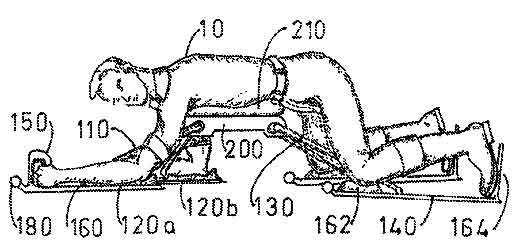Marc Abrahams's Blog, page 178
July 26, 2018
Shocking fish therapy for hemorrhoids (and other ailments)
 If you were unfortunate enough to be suffering from hemorrhoids, would you consider applying 350 volt electric shocks to the affected area – supplied via an electric fish? Improbable though it may seem, such practices were well known in Roman times – predating modern TENS machines by some 2000 years.
If you were unfortunate enough to be suffering from hemorrhoids, would you consider applying 350 volt electric shocks to the affected area – supplied via an electric fish? Improbable though it may seem, such practices were well known in Roman times – predating modern TENS machines by some 2000 years.
“Ecclesiastes 1:9 states that there is ‘nothing new under the sun’; and such is the case with electrical stimulation. Aristotle, Pliny, and Plutarch recognized the numbing effect of electricity when referring to the application of the torpedo fish to the body. Scribonius Largus advocated the use of piscine electrotherapy for the relief of pain associated with gout, headache, arthritis, and hemorrhoids. Various means of providing electrical current were developed, including the use of the electric ray or great Nile catfish.“ [our hyperlink]
See: ‘The use of transcutaneous neural stimulation and isokinetic testing in arthroscopic knee surgery’, The American Journal of Sports Medicine, Volume: 13, issue: 1, page(s): 27-33.
Also see [electrically related]: The history of voltaic piles.
Coming soon: The medical applications of electric cattle fences.
The photo of Malapterurus electricus is courtesy Stan Shebs @ Wikpedia.

July 25, 2018
Using Electricity to Enhance Flavor: Electric Chopsticks
Electricity can add spice, so to speak, to taste. That is the implication of this new research study about electrified chopsticks, an electrified soup bowl, and other electrified eating utensils:
“Augmented Flavours: Modulation of Flavour Experiences Through Electric Taste Augmentation,” Nimesha Ranasinghe, David Tolley, Thi Ngoc Tram, Nguyen, Liangkun Yan, Barry Chew [pictured here], and Ellen Yi-Luen Do, Food Research International, epub 2018. The authors, at the National University of Singapore, Singapore, the University of Maine, and the University of Colorado Boulder, report:
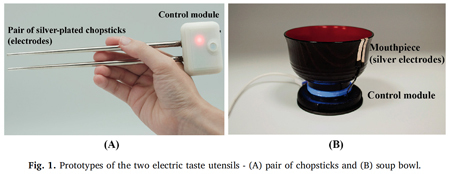

Barry Chew, co-inventor of electric chopsticks.
“[We] have created two utensils, a pair of chopsticks and a soup bowl, that apply controlled electrical pulses to the tip of the tongue during consumption in order to augment flavours through electrical stimulation. As such, in this paper we present a study that aimed to evaluate the impact of electric taste augmentation on two types of eating experiences: consuming mashed potato and miso soup. Based on this study, our findings demonstrate that 1) significant increases in perceived saltiness and sourness can be achieved when consuming unsalted mashed potato and 2) significantly higher ratings of sourness can be achieved when consuming diluted miso soup.”
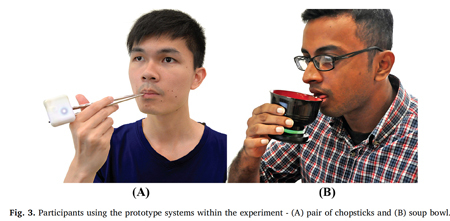
The team at the University of Singapore provides additional info, on their web site. They produced this promotional video, in which they reveal their invention of two additional electrified eating utensils:

July 24, 2018
Do Test-Takers Pay Attention to Rock Lyrics? [research study]
“Effects of Aggressive and Nonaggressive Rock Songs on Projective and Structured Tests,” C.E. Wanamaker and M. Reznikoff, Journal of Psychology, vol. 123, no. 6, November 1989, pp. 561-570. The authors, at Fordham University, Bronx, NY, conclude that:
“The findings are congruent with other investigators’ reports that subjects do not pay attention to rock lyrics. ”
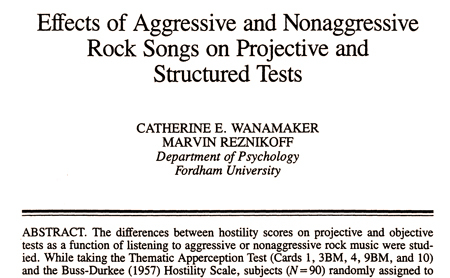
 Read that and more, in the column “Music and Noise Research—Explorations of artistic and other vibrations” [free, downloadable PDF], in the special NOISE issue of the Annals of Improbable Research.
Read that and more, in the column “Music and Noise Research—Explorations of artistic and other vibrations” [free, downloadable PDF], in the special NOISE issue of the Annals of Improbable Research.
For heaps of improbable research, subscribe to the magazine (or if you like, buy single issues). The magazine has six new issues a year, all in PDF form.

July 23, 2018
In Theory: A Short Abstract
Ig Nobel Prize winner Ray Goldstein is receiving compliments for his newly published biophysics paper—because the paper’s entire abstract is one (1) word in length.
The New Paper
 The paper is: “Are Theoretical Results ‘Results’?” Raymond E. Goldstein, eLife, vol. 7, no. e40018, 2018. The abstract reads, in its entirety:
The paper is: “Are Theoretical Results ‘Results’?” Raymond E. Goldstein, eLife, vol. 7, no. e40018, 2018. The abstract reads, in its entirety:
Yes.
Goldstein is in the Department of Applied Mathematics and Theoretical Physics, Centre for Mathematical Sciences, University of Cambridge, UK.
The 2012 Ig Nobel Prize for physics was awarded to Joseph Keller, Raymond Goldstein, Patrick Warren, and Robin Ball, for calculating the balance of forces that shape and move the hair in a human ponytail.
An Earlier, Longer Abstract From Another Ig Winner
A few years ago, Michael Berry, himself an Ig Nobel Physics Prize winner, co-authored a paper that has what some people called “the best abstract ever.”
That paper is: “Can apparent superluminal neutrino speeds be explained as a quantum weak measurement?“, M.V. Berry, N. Brunner, S. Popescu and P. Shukla, arXiv:1110.2832, 2011. The abstract reads, in its entirety:
Probably not.
The 2000 Ig Nobel Prize for physics was awarded to Andre Geim and Michael Berry, for using magnets to levitate a frog.
An Ig Nobel Tradition of Paying Attention to Words
The 2006 Ig Nobel Prize for Literature was awarded to Daniel Oppenheimer for his report “Consequences of Erudite Vernacular Utilized Irrespective of Necessity: Problems with Using Long Words Needlessly.”

I Would Code Anything for Love (but I Won’t Code That)
Taking the term “Rockstar Programmer” to a new level—well, perhaps they’re half way there?—Dylan Beattie has developed a programming language called Rockstar that allows people to live their wildest dream of writing code that resembles a 1980s rock song: Rockstar is designed for creating computer programs that are also song lyrics, and is heavily influenced by the lyrical conventions of 1980s hard rock and power ballads.
A snippet of example code from Rockstar’s GitHub page illustrates that rock and roll never forgets.

They say the heart of rock and roll is still beating. And from what I’ve seen I believe ’em.
Rockstar is a Turing-complete programming language, so one can use it to simulate any Turing machine. And it goes on and on and on.
And if you’ve got too much time on your hands, perhaps you may even want to give it a try?
(Thanks to investigator Samuel Arbesman for bringing this to our attention.)
Note: The song that motivated the entry title is actually from the 1990s, and I hope you caught that. Rock on!

Walk like a lizard, like a spider, close to the ground, with the newly patented Quadra Walker™
“There is no known mechanical apparatus enabling a human being to walk in a prone position, like a lizard, like a spider, close to the ground, using arms and legs as will be made possible with the Quadra Walker (QW) disclosed herein.”
Its inventor, Herbert Russell Burnham of Chula Vista, California, explains in a newly released US patent document, that :
“Walking in a prone position, close to the ground, is a new concept which will afford human beings with a new travelling experience on open ground or through underbrush, through thick forests, climbing slopes or walking on water, and on the fields of competitive sports.“
See: United States Patent 10,011,311, July 3, 2018

July 20, 2018
Loud Complaint: Babcock’s Cast-Iron Piano Frames [research study]
“Alpheus Babcock’s Cast-Iron Piano Frames,” Keith G. Grafing, The Galpin Society Journal, vol. 27, May 1974, pp. 118-124. The author reports:
“Babcock’s claim was not undisputed however, since there had been experiment with the iron frame prior to the 1825 date of his patent. A lively dialogue between Babcock and another piano maker, Thomas Loud, dramatized the conflicting views over the use of the iron frame.”
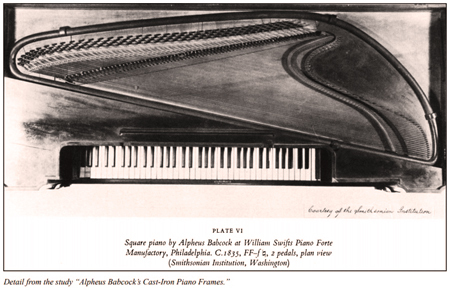
 Read that and more, in the column “Music and Noise Research—Explorations of artistic and other vibrations” [free, downloadable PDF], in the special NOISE issue of the Annals of Improbable Research.
Read that and more, in the column “Music and Noise Research—Explorations of artistic and other vibrations” [free, downloadable PDF], in the special NOISE issue of the Annals of Improbable Research.
For heaps of improbable research, subscribe to the magazine (or if you like, buy single issues). The magazine has six new issues a year, all in PDF form.

July 19, 2018
When Buttock Implants Shift – and what to do about it (new patent)
“Simply put, any male or female who feels or perceives their buttock size, shape, &/or proportions are not adequate . . .”
– might consider gluteal implants. But gluteal implants, like many other implants, are prone to shifting :
“[…] current implants are unstable and prone to shifting after implantation, which can cause a host of problems for both patients and doctors alike.”
A newly patented method to help prevent gluteal implants from moving from their desired location is provided by Ryan A. Stanton, M.D., Inc. of Beverly Hills, California, US. 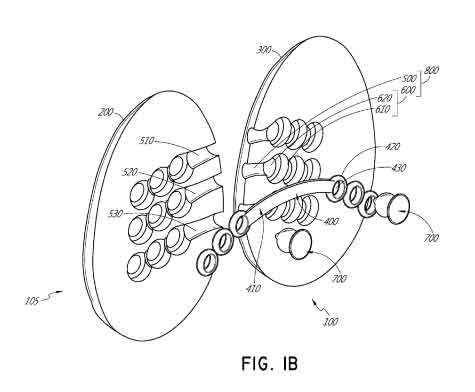 As may be appreciated by the drawing above, a pair of implants can be “linked, coupled, attached, [or] leashed” together with a “restraining connector” which makes mal-positioning less likely.
As may be appreciated by the drawing above, a pair of implants can be “linked, coupled, attached, [or] leashed” together with a “restraining connector” which makes mal-positioning less likely.
See: US patent 10,004,585, June 26, 2018 Gluteal implants and implant systems

July 17, 2018
Non-Word and Word Noises During Sex [research study]
“An Examination of Predictors of Nonverbal and Verbal Communication of Pleasure During Sex and Sexual Satisfaction,” Elizabeth A. Babin, Journal of Social and Personal Relationships, vol. 30, no. 3 2013, pp. 270-292. (Thanks to Ig Nobel Prize winner Geoffrey Miller for bringing these to our attention.) The author, at Cleveland State University, reports:
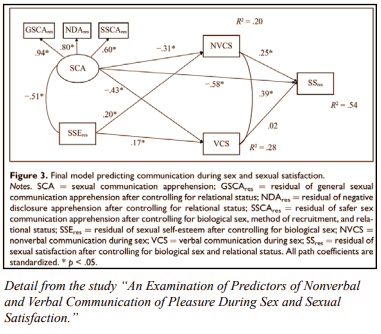
“Verbal communication during sex did not predict sexual satisfaction. The findings draw attention to the need for scholars to examine both verbal and nonverbal forms of sexual communication, as well as factors that might influence the extent to which individuals communicate sexual pleasure during sexual encounters…. The original scale reported in Brogan et al. (2009) asked participants to report on their partner’s communication during sex. To fit the needs of this study, the SCSS [Sexual Communication Style Scale] was adapted to measure participants’ own communication during sex.”
 Read that and more, in the column “Improbable Sex” [free, downloadable PDF], in the special NOISE issue of the Annals of Improbable Research.
Read that and more, in the column “Improbable Sex” [free, downloadable PDF], in the special NOISE issue of the Annals of Improbable Research.
For heaps of improbable research, subscribe to the magazine (or if you like, buy single issues). The magazine has six new issues a year, all in PDF form.

July 16, 2018
10 tips that media library specialists are advised to not follow
 What can be done about the troublesome numbers of overdue library books? A set of strategies (10 in number) is provided by Bacon, Pamela S. in the journal Library Media Connection. For example:
What can be done about the troublesome numbers of overdue library books? A set of strategies (10 in number) is provided by Bacon, Pamela S. in the journal Library Media Connection. For example:
• ‘Never allow students to renew a book’
• ‘No matter what the question . . . always say no first’
• ‘Practice saying “shhh” with as much resentment as you can manage’
&etc
The author clarifies :
“Obviously, you’ve figured out by now that no practicing media library specialist would ever follow these 10 tips. But the more I thought about it, the more I decided that overdues weren’t so bad after all.”
– in the sense that the implication is that students are actually reading more rather than less, and are probably also sharing books amongst their friends.
“Sure, overdues still bother me – but given the alternative I wouldn’t have it any other way!”
See: Don’t Overdo Worrying about Overdues! Library Media Connection, v24 n3 p45.
Observation: Should you require more info on research into ‘overdues’, then the following is also of note :
“Very little research on overdues and fines has been carried out at UK university libraries; this study aims to address this gap in the literature.”
The quote is from a 2013 study, performed at Leeds University, UK, which not only examined the reasons why students don’t return books on time (for example, because they forgot, because they didn’t realise it was overdue, or had lost it &etc.) but also suggest a variety of strategies to combat the practice – including a one-off fines amnesty.
See : Overdue books at Leeds University Library Journal of Librarianship and Information Science, Volume: 46 issue: 3, page(s): 226-242

Marc Abrahams's Blog
- Marc Abrahams's profile
- 14 followers


